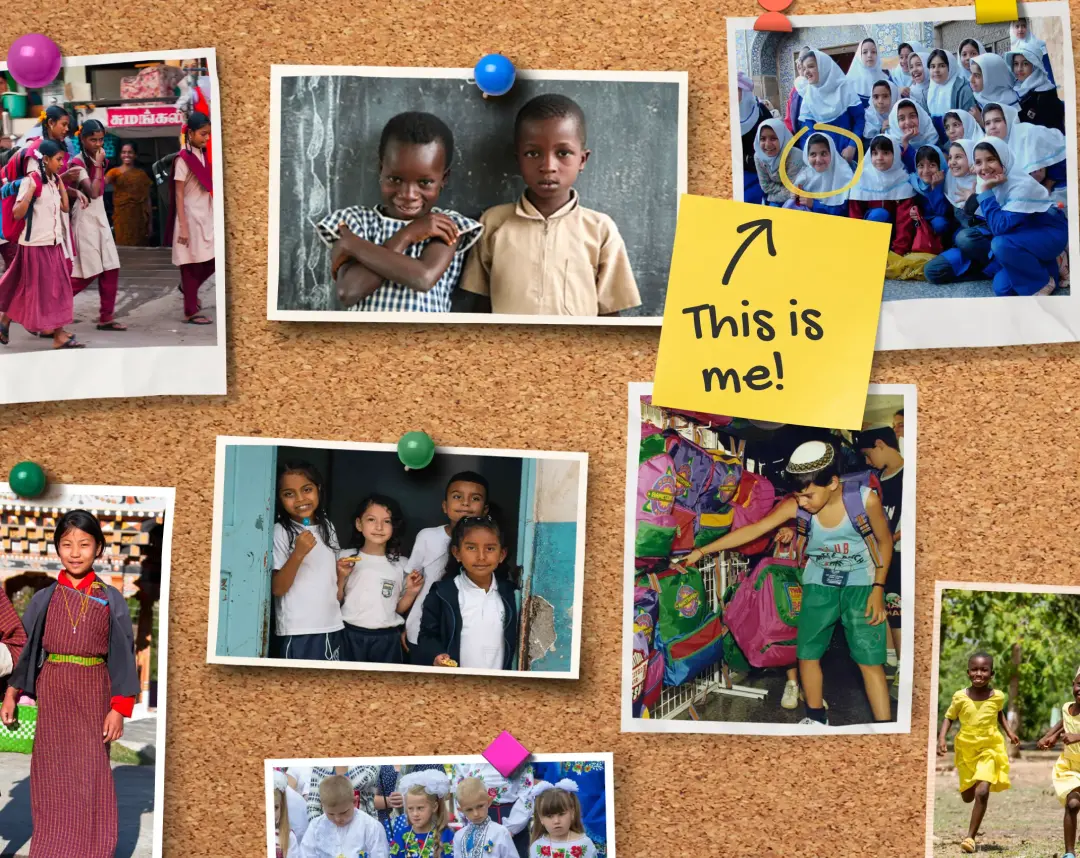Where did school bags come from?

Kids had few school supplies in the 1800s; they were pricey. But over the next century, more subjects were taught, meaning more books! New inventions like notebooks became common school supplies. School bags helped to carry them and keep them safe.

Imagine having no homework! In some countries like Finland, children don’t have it. When homework became popular in the 1900s, kids started carrying heavier school bags. How much lighter would your school bag be without homework?
How have school bags changed?

Remember Peder’s huge bag? It’s over 40 centimetres wide and high! How does your school bag compare? Is it bigger or smaller?

This bright yellow bag with red reflectors made its owner visible day and night! How can your school bag help keep you safe?

School bags can show others our likes, our heroes or where we’re from. What do you think the owner of this bag likes?
So many bags!
Did you know there were so many different types of school bags? They’ve evolved a lot over time. Technology has influenced what we learn and how we learn it. We take different things to school now than we did 100 years ago, and we need different bags to carry them in! How does your school bag compare to these Swiss school bags from the 1900s?

What’s essential?
What are the most important qualities in a school bag? Should it look cool or be comfortable? Does it need lots of pockets or zips? This yellow one is flashy, but it doesn’t have any pockets. Nowadays you can find all kinds of school bags to suit your needs. What’s your dream school bag?

What helps us learn?
From the classics like pens and paper to video games and digital books! Find out how the things we carry in our backpacks can help us learn.
Did
you
know
?

Playing isn’t just for fun
Playing also helps you learn. When you’re playing outside, for example, you can ask questions and find out the answers. What happens when we roll items of different weights down the same hill? Can a leaf tell us what kind of tree it comes from? This is fun and also helps you think about science. Adults need a little playtime too! Charlotte Anne Wright, Ally S. Masters, and Kathy Hirsh-Pasek, researchers
Heavy load or traveling light?

Organising your school bag and packing only what you need for the day can help keep things light! Agendas can help you remember what to pack. Don’t forget to bring snacks, drinks and other essentials. What do you put in your bag?

There are places in the world where kids come to school without any school supplies. Some schools and families can’t afford them. It also can be difficult to get materials in areas of conflict and war. What are your essential school supplies?
Snack time!
What kind of lunch or snack do you usually bring to school? Do you prefer a bag of crisps or fresh fruit? Eating too much sugar or junk food can make you feel tired. It’s no fun being tired at school. Give your brain a boost with healthy meals that include fruit and vegetables, and drink plenty of water!

What’s your dream school?
Schools all over the world are different. What’s your school like?
Some have outdoor classrooms, some have big screens, some focus on learning by doing rather than books. Some have cafeterias and water fountains and some don’t. If you could design a school, what would it look like?


No gross books, please!
Have you ever put a book under your pillow and hoped that the next day you would magically know it by heart? That might not be the best way to learn. But what about eating books? Some scientists think that books that taste like the things they describe could help children learn better. Let’s hope those books are all about tasty treats!

Sit up straight!
Do you sit up straight at school? Good posture is important for your back and body. Regular exercise and breaks from long periods of sitting also help. In the 1800s, someone invented a rather strange device to make children sit up straight. It looks pretty awful, doesn’t it? How do you maintain good posture at school?

No homework!
In the past, homework was sometimes banned for children in England or in the United States of America. Homework can help us learn, but it can also rob us of our free time after school. Yes, it’s important to keep up at school – but it’s also important to be with friends and family and enjoy activities outside of it. Would you ban homework?
Want to know more?
Bibliography
Angerhn, P., Bieger, A. (2013). Vom Kuhfellranzen zum Lillifeethek. Stiftung Schulmuseum Mühlebach.
Christen, S., Eggenberger, R., Luchsinger, K., Truniger, P., & Bieger, A. (2016). Schlüsselherz und Stiefelknecht : Handarbeits- und Werkunterricht von 1870 bis 2014 (1. Edition). Lehrmittelverlag.
Cuban, L. (1986). Teachers and machines : the classroom use of technology since 1920. Teachers College Press.
Hale, L. (2015, November 2). From “book strap” to “burrito”: A history of the school backpack. NPR. https://www.npr.org/sections/ed/2015/11/02/445339503/from-book-strap-to-burrito-a-history-of-the-school-backpack
Kucirkova, N. (2024, January 11). The promising world of Children’s digital books. BOLD. https://bold.expert/the-promising-world-of-childrens-digital-books/
Lawn, M. (2005). Materialities of schooling : design, technology, objects, routines. Symposium Books.
Michnick Golinkoff, R., & Kucirkova, N. (2024, March 26). Digital Books for children affected by War. BOLD. https://bold.expert/digital-books-for-children-affected-by-war/
Ruggiero, A. (2023, March 13). Enhancing children’s learning through media and Technology. BOLD. https://bold.expert/enhancing-childrens-learning-through-media-and-technology/
Ruggiero, A. (2023, March 13). Enhancing children’s learning through media and Technology. BOLD. https://bold.expert/enhancing-childrens-learning-through-media-and-technology/
Schiffler, H., & Winkeler, R. (2011). Tausend Jahre Schule : eine Kulturgeschichte des Lernens in Bildern. Belser.
Zoppi, B., & Marino, M. (2023). Schule früher - Kuhfellranzen und Tintenfass : Anschauungsmaterial von ca. 1920-1970. Schulmuseum Bern.
Learning objectives
Based on Curriculum 21, German-speaking Switzerland, 2024.
The students …
NMG 5.3 for 9+
1 b) can recognise and assess the significance of technological developments in devices and systems for everyday life today (e.g. the printing press, digital devices and the Internet).
NMG 9.1 for 9+
2 g) can classify periods of history on a timeline.
NMG 7.2 for 9+
1 c) can ask questions on selected topics relating to the daily lives and lifestyles of people in distant parts of the world, and be guided in gathering, organising and reporting information (living, eating, living together, working, being on the move).
Additional learning objectives:
can identify and describe the purpose of various school items such as textbooks, calculators, notebooks, etc.
can understand and describe different study techniques including note-taking, flash cards and mind-mapping.
Copyright and licenses
Images in the timeline
Printing press: a game changer! Gutenberg and Fust with the first printing press Germany 1450s […], North Wind Picture Archives / Alamy Stock Photo, © North Wind Picture Archives / Alamy Stock Photo.
The invention of lithography Prang’s aids for object teaching. Lithographer, L. Prang & Co., Library of Congress Prints and Photographs Division, no known restrictions on publication.
The world’s smallest school bag Schooltas, Hart Amsterdam Museum, CC0.
Wooden school bags: who knew? Schooltas, Zuiderzeemuseum Enkhuizen CC-BY-SA.
One of the world’s largest school bags! Ransel, Ann Kristin Leirmo, Lesja bygdemuseum/ Gudbrandsdalmusea, © Lesja bygdemuseum / Gudbrandsdalmusea.
What did Christian bring to school? Unser ältester Schulthek, Digital Museum of Learning, Schulmuseum Bern, CC BY 4.0.
VR in the 1800s? Stereoskop, Digital Museum of Learning, Schulmuseum Bern, CC BY 4.0.
Sled or school bag? Tornister aus Schaffhausen, Digital Museum of Learning, Schulmuseum Bern, CC BY 4.0.
What about lunch? Boy on way home from school […], Jack Delano, Library of Congress, Public Domain.
Silent movies to replace textbooks! Hyde Park School room 2, American Mutoscope & Biograph Company, Library of Congress, no known restrictions.
100 years of radio learning REA, Little girl by Radio” – NARA – 195876, 1933-1945, U.S. National Archives and Records Administration, Public Domain
Have school bags changed? Maleta ABC Jumbo, Manuel Antonio Moreno Lara/Maletas ABC, ©Maletas ABC.
Television at school 1950s back view of kids in school library watching tv screen, H. Armstrong Roberts, ClassicStock /Alamy Stock Photo, © ClassicStock /Alamy Stock Photo.
The Little Professor Texas Instruments Little Professor, Digital Museum of Learning, Schulmuseum Bern, CC BY 4.0.
Fur-tastic school bags: the Kuhfellranzen Kuhfellranzen, Digital Museum of Learning, Schulmuseum Bern, CC BY 4.0.
The personal computer Persondator by Commodore, Swedish National Museum of Science and Technology, Sweden, CC BY.
Imagine life without the Internet! Tim Berners-Lee, World Wide Web Inventor, CERN, © CERN Some rights reserved. This image is freely available for non-commercial use.
Scout backpack Schulthek ‘Skater’, Digital Museum of Learning, Schulmuseum Bern, CC BY 4.0.
What makes the perfect backpack? Fjällraven AB by Christian Krug at Museum Europäischer Kulturen, Staatliche Museen zu Berlin, CC-BY-SA 4.0.
Smartphones and tablets Children sitting on stool and using smartphone, uncoveredlens Eze Joshua, via pexels.com, Public Domain.
Images in the cover image
Gelber Schulthek, Digital Museum of Learning, Schulmuseum Bern, CC BY 4.0.
Texas Instruments Little Professor, Digital Museum of Learning, Schulmuseum Bern, CC BY 4.0.
Nach der Schule, Ferdinand Georg Waldmüller, Staatliche Museen zu Berlin, Nationalgalerie/Jörg P. Anders, Public Domain Mark 1.0.




























